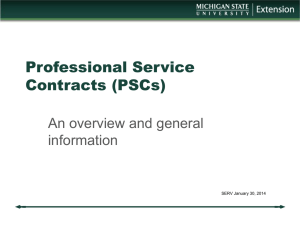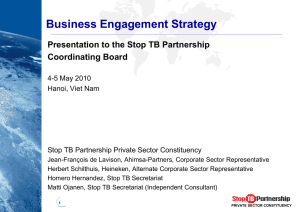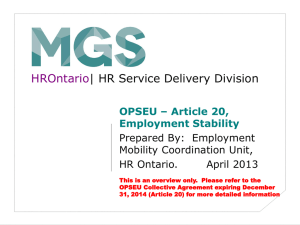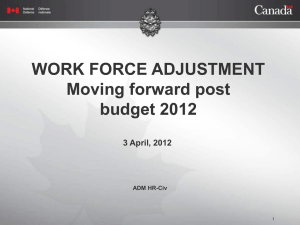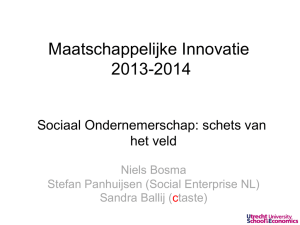P021Slides-Module1
advertisement
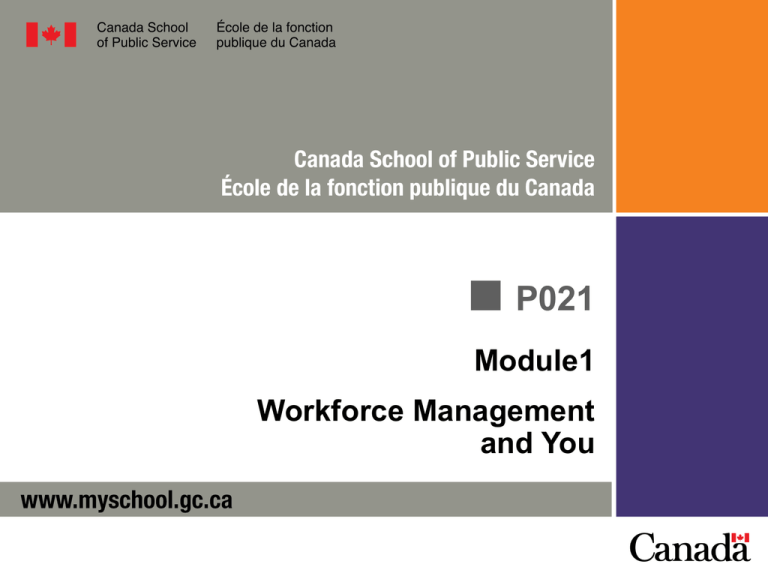
P021 Module1 Workforce Management and You Objective Participants are able to apply the workforce directive in the context of a required workforce adjustment. Canada School of Public Service │ www.myschool.gc.ca 2 What do YOU think? Based on your knowledge and experience, what does workforce adjustment mean to you? Canada School of Public Service │ www.myschool.gc.ca 3 Prime Minister Clerk of the Privy Council Speech from the Throne Treasury Board Ministers Departmental DM and ADMs Budget reductions, A base, EMS, Strategic and operational Reviews MAF, RPP, DPR, PAA, MRRS, PMA, etc Strategic Planning (Strategy creation and management) Senior Managers Departmental Senior Managers and Middle Managers Departmental Senior Managers and Managers Departmental Managers and Human Resources Office TBS delegation instruments Environmental Scan Tactical Planning (Initiatives Management-Infrastructure and Processes) New vision, mandate, services, program orientation, org structure, functions, accountabilities, delegations Tactical Planning (Initiatives ManagementInfrastructure and Processes) Workforce Reduction Implementation and Ongoing Management Departmental Employee, Manager and Human Resources Office Canada School of Public Service │ www.myschool.gc.ca Employability Maintenance/ Career Management Integrated HR and Business Planning Communicate to employees, unions, TBS and PSC Communicate and offer assistance, options and services to affected, surplus, opting employees as well as non-affected and non-surplus employees. Notify PSC as required Update résumé, seek assistance, activate your network, advertise your qualifications, share your interests, keep positive 4 WFA Situation? Work Force Adjustment (WFA) is a situation that occurs when the services of one or more indeterminate employees will no longer be required beyond a specified date due to one of the following reasons: A lack of work; The discontinuance of a function; A relocation in which the employee does not wish to relocate; or Implementation of an Alternative Delivery Initiative (ADI) initiative where the work is to be transferred to the private sector or to another level of government or to a separate employer in the Public Service, for example, a new federal agency. Canada School of Public Service │ www.myschool.gc.ca 5 Agreements on Work Force Adjustment 4 Agreements NJC Directive; Appendix to PSAC collective agreements; Appendix to PIPSC collective agreements; and Appendix to UCCO-SACC collective agreements (CXs) Canada School of Public Service │ www.myschool.gc.ca 6 Legal Authorities for Surplus and Lay-off Declaration Public Service Commission Public Service Employment Act (PSEA): -S 64 gives deputy heads the authority to lay off employees in accordance with PSC regulations; and -S 22 gives the PSC the authority to regulate the manner in which employees are to be laid off, and the means of selecting these employees. Public Service Employment Regulations: -S 21 requires that selection for retention be based on merit, and that the remaining employees be advised that they are to be laid off. 7 Canada School of Public Service │ www.myschool.gc.ca 7 Administrative Authorities and Delegated Authorities Administrative Authorities Delegated Authorities Work Force Adjustment Directive (WFAD); WFA decisions are delegated to the Deputy Head; Work Force Adjustment Appendix (WFAA)-in some of the Collective Agreements; DH retains authority related to Ex and Leadership Development Program 8 Canada School of Public Service │ www.myschool.gc.ca 8 Active Players-Roles and Responsibilities Treasury Board Secretariat (TBS)/Office of the Chief Human Resources Officer (OCHRO) HR Directorate HR Planning Public Service Commission (PSC) Classification National Joint Council Staffing Bargaining Agents Labour Relations Work Force Adjustment Committee (WFAC) Compensation Pension Departments Counselling and EAP Management Employees 9 Canada School of Public Service │ www.myschool.gc.ca 9 In a workforce adjustment context what are the main responsibilities of an affected or surplus employee? 10 Canada School of Public Service │ www.myschool.gc.ca 10 Employee’s right To be advised in writing that his/her services are no longer required AND to be informed of entitlements: Guarantee of a Reasonable Job Offer (GRJO) “Surplus” employee (confers a PS-wide priority status); OR No Guarantee of a Reasonable Job Offer “Opting” employee: employee has 90 to 120 days*(as per the applicable WFA agreement) (“opting” period) to consider three options* a. -12 month paid surplus period; OR b. -A lump sum payment called Transition Support Measure (TSM); OR c. -TSM plus up to either $7,000 or $11,000 for tuition and other related fees Opting also entitles employees to between $385 and $600 for counselling 11 Canada School of Public Service │ www.myschool.gc.ca 11 Reasonable Job Offer (RJO) An RJO is a written offer of indeterminate employment in the core public administration may be at another location; may be in another organization; normally to a position at an equivalent or lower level paying job with salary protection. The employee must be trainable and mobile. A reasonable job offer is also a job offer from an employer listed in Schedule V of the Financial Administration Act (e. g. Canada Revenue Agency, Parks Canada), provided that: a) the appointment is at a rate of pay and an attainable salary maximum not less than the employee’s current salary and attainable maximum b) it is a transfer without interruption in benefits (sick leave credits, severance pay and accumulated annual leave credits) 12 Canada School of Public Service │ www.myschool.gc.ca 12 Guarantee of a Reasonable Job Offer (GRJO) When an employee receives a GRJO, he/she remains on paid surplus status and maintains a priority entitlement until: • he/she is placed; or • he/she chooses to resign; or • he/she refuses an RJO. When an employee refuses an RJO: • employee can be laid off one month after; • but not sooner than 6 months from the date of being declared surplus; and • employee does not have access to any lump sum payments or waiver of pension penalty. 13 Canada School of Public Service │ www.myschool.gc.ca 13 No Guarantee of a Reasonable Job Offer Specific factors: little probability of placement within the next 12 months. employee is very specialized and retraining would be complicated and inappropriate; activity level in the priority system; the Core Public Administration no longer employs the skills of the employee in question; work location is in a remote area with little federal government presence and the employee is not mobile; and 14 Canada School of Public Service │ www.myschool.gc.ca 14 Flow Chart- Work Force Adjustment Directive Work Force Adjustment • Deputy Head decides that the services of one or more indeterminate employees will no longer be required due to: lack of work; discontinuance of function, relocation (where employee refuses to relocate); or alternative delivery initiative. • Deputy Head must determine which employees will receive a GRJO and which ones will become “opting” employees. Employee with a GRJO On surplus priority status until receives/accepts a RJO, is laid-off or resigns. Employee Accepts RJO • Removed from surplus priority status. Employee refuses RJO • Laid-off but no sooner than 6 months from beginning of surplus period; •Layoff priority status (unpaid) for 1 year. Canada School of Public Service │ www.myschool.gc.ca Opting Employee – No GRJO Employee has 90 to 120 days to choose one of three options depending on which agreement applies Option A: 12-Month Surplus Status to Secure a RJO •Receives/accepts RJO. • If does not receive/accept RJO, is laid (no sooner than 6 months) off with layoff priority status for 12 months (unpaid). •If no RJO received /accepted during layoff priority status, entitlement ceases. No longer an employee of PS. Option B: Transition Support Measure (TSM) • Employee resigns. • Receives cash payment of up to 52 weeks salary, based on years of service. Option C: Education Allowance • Cash payment equivalent to TSM plus education allowance of up to $11,000. • Employee resigns or takes leave without pay (LWOP) for up to 2 years to pursue education. • After LWOP, If no alternate employment is found employee is laid off with layoff priority status for 12 months (unpaid). 15 • Work Force Adjustment Process Map Employee accepts a position during the Affected Period Employee can be referred to positions within the Department DH decides which employees will be affected Employee receives Surplus letter with a GRJO DH decides which employees are surplus DH decides which surplus employees will receive a GRJO Employee receives Opting letter Alternation Program: Employee exchanges positions with a nonaffected employee willing to leave with TSM or Education Allowance Employee accepts RJO Employee becomes surplus priority and is referred to positions across the PS Option 1: 12 month surplus status with priority entitlement 90 or 120 days to pick option Option 3: Transitional Support Measure + Education Allowance Canada School of Public Service │ www.myschool.gc.ca Employee receives RJO After 12 months Option 2: Transitional Support Measure Employee takes LWOP for up to 2 years, attends a recognized learning institution and is reimbursed for eligible fees Employee resigns from the PS, attends a recognized learning institution and is reimbursed for eligible fees Employee refuses RJO Employee is laid off and is entitled to layoff priority status for 12 months Employee is referred to positions across the PS After LWOP period, employee is laid off and is entitled to layoff priority status for a 12 month period Employee accepts a job offer After 12 months, priority entitlement ceases 16 Who is entitled to retraining? 17 Canada School of Public Service │ www.myschool.gc.ca 17 COMPENSATION AND BENEFITS Salary Protection-Appointment to Lower Level Position Leaving the Public Service Working with an outside Employer or Rejoining the Public Service After Cessation of Employment Severance Pay on Leaving the Public Service Leave Credits Insurance Benefits upon Lay-Off Other deductions such as Canadian or Quebec Pension Plan, Canada Saving Bonds, Superannuation WFA Lump Sum Payments, etc. 18 Canada School of Public Service │ www.myschool.gc.ca 18 What your manager needs to tell you Invite you to attend a meeting. As soon as possible (beginning / middle of the week) Follow up session, if required In confidentiality (closed door / private room / no interruptions) Give you a letter that tells you about your status Inform you about your status Give you time to read letter Inform you of the basis of that decision Give you time to ask questions Support you Encourage you to renew and update you résumé EAP, HR and Union coordinates Continue to inform you 19 Canada School of Public Service │ www.myschool.gc.ca 19 Some Possible and Normal Employee reactions/needs What are some of the possible reactions a given employee will experience upon receipt of a surplus letter? What are the employee’s needs at that moment? Reactions Needs 20 Canada School of Public Service │ www.myschool.gc.ca 20 Possible Employees Coping Strategies Take a few minutes to identify some employee coping strategies that would work for you to help you overcome the reactions to a bad news. 21 Canada School of Public Service │ www.myschool.gc.ca 21 Selecting employees for retention and lay-off Process/Steps to be taken by management: 1. Determine the part of the organization that is affected; 2. Identify the similar affected positions and employees; 3. Determine the merit criteria and assessment methods; 4. Communicate decisions to employees; 5. Assess and select employees; 6. Communicate results to employees; and 7. Appoint the qualified employees 22 Canada School of Public Service │ www.myschool.gc.ca 22 • Priority Search/Referral/Clearance Organization Submits Request to PSC for Priority Clearance (through PIMS) Priority person (s) Self-Refer PIMS Identifies Potentially Qualified Priorities in the Database PSC issues Automatic Clearance Org re-submits search with correct criteria No priority person identified Indeterminate positions OUT PSC monitors org search criteria PIMS provides names - PSC Screens PSC issues clearance Org continues process Search criteria inaccurate, org cancels, submits new search Search criteria accurate PSC Issues clearance Priority NOT qualified Org continues process Org continues process Canada School of Public Service │ www.myschool.gc.ca Priority person(s) identified Term positions IN PIMS provides names - Org screens PSC refers to Org Org assesses & reports to PSC --------------------------------------PSC reviews Priority qualified Org makes offer PSC rejects, requests more info Org provides additional Info 23 Why consider a Priority Person It is not just the law, it is a corporate responsibility that crosses all federal organizational boundaries and all managerial and executive levels; Appointing persons with priority entitlements assists the public service in retaining competent employees; and Managers have access to a database of potentially qualified persons who can be appointed quickly and efficiently. 24 Canada School of Public Service │ www.myschool.gc.ca 24 Order of Priority Entitlement There is a ranked order to priority entitlements based on the legislation: “Statutory” priority entitlements in the Public Service Employment Act take precedence over the “regulatory” priority entitlements found in the Public Service Employment Regulations; and There is a further ranked order to the statutory priorities 25 Canada School of Public Service │ www.myschool.gc.ca 25 Documents Required by the PSC • PIMS Electronic Registration Form - consent form must be signed by the priority person and retained in organization’s file; • Current CV; • Letter advising you of your status (leave of absence, lay off, surplus, etc); and • Other documents, including security clearance and language assessment results, should be retained on the organization’s file and may be requested by the PSC Canada School of Public Service │ www.myschool.gc.ca 26


